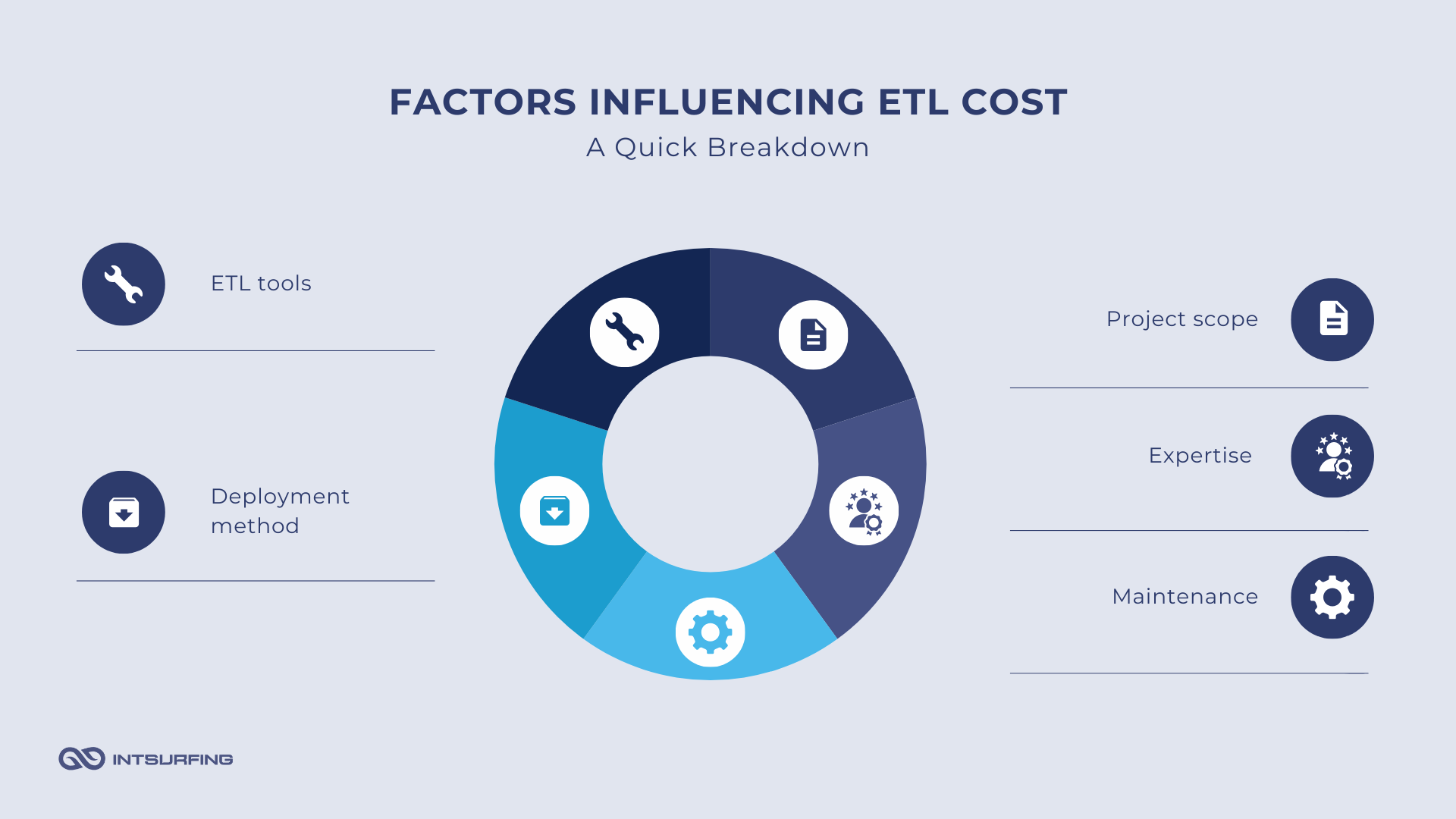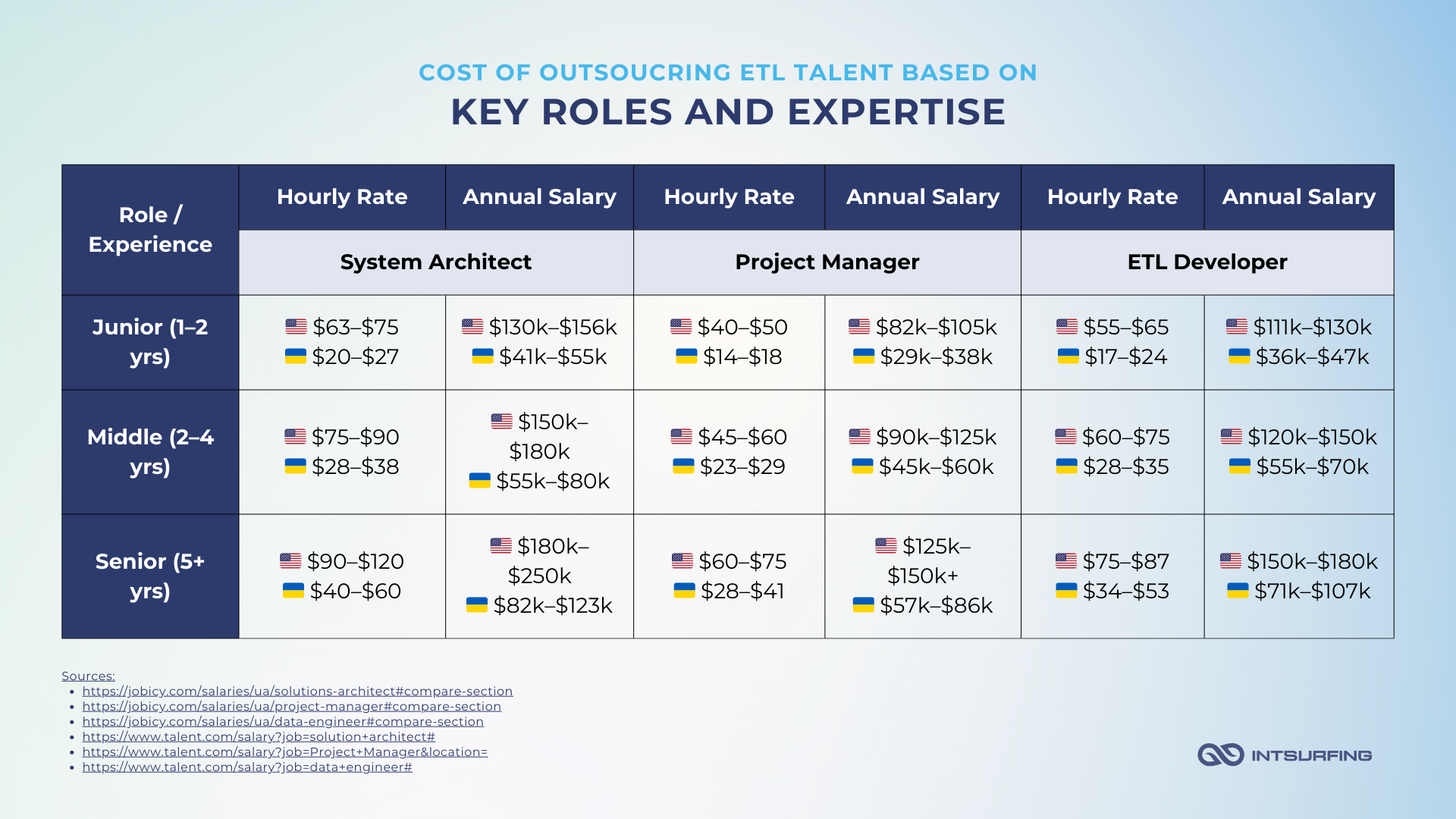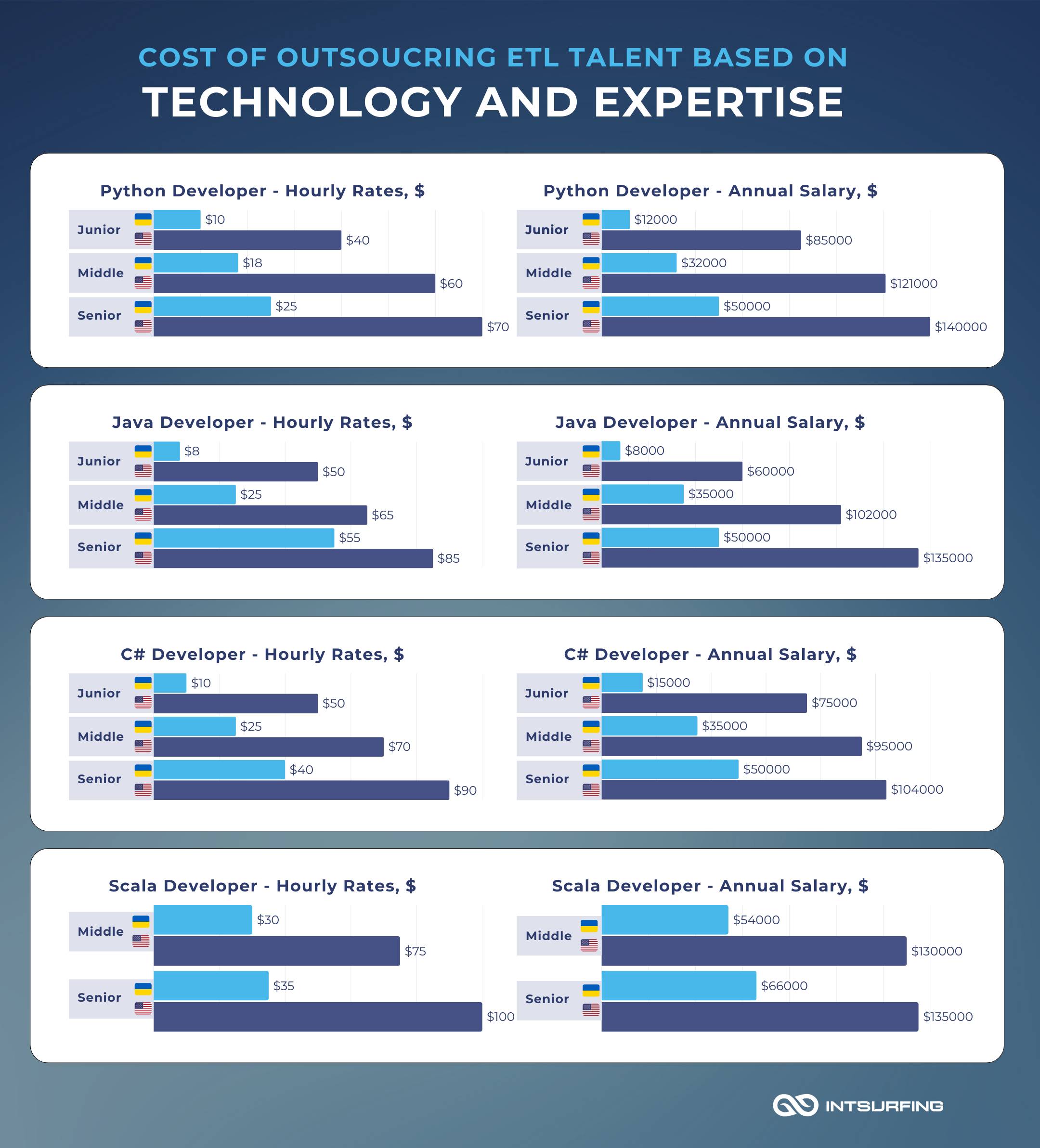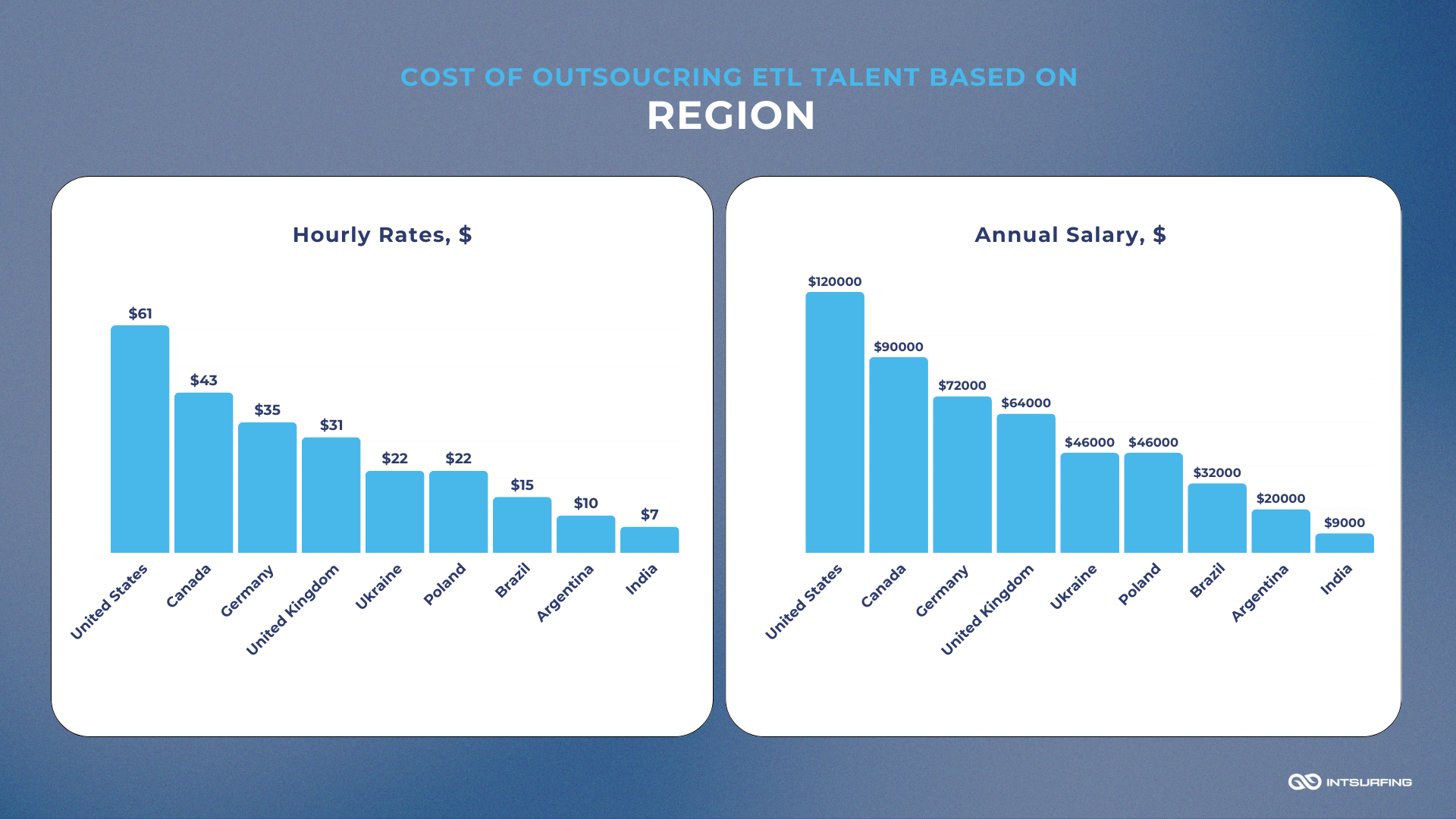Consider ETL implementation? Then you’re probably thinking about cost—understandably!
In our experience, smaller and mid-sized firms usually budget between $20,000 and $100,000 annually for cloud-based, fully managed ETL solutions.
On the other hand, bigger corporations regularly see annual costs between $100,000 and well over $500,000.
However, it’s common for the first year of an ETL deployment to be the most expensive, accounting for installation, customization, and staff onboarding. During project maintenance, the expenses usually go down. But not always.
So, what drives these differences?
In this article, we’ll explore what makes ETL prices vary so much.
Let’s dig in.
Factors Influencing ETL Costs
So, what’s driving the cost of your ETL system?
It’s a mix of factors: the ETL tools you opt for, your deployment method, the project’s scope, customization needs, the expertise involved, and maintenance demands.

Let’s unpack the key factors influencing ETL pricing.
1. ETL Tool Costs
When choosing an ETL tool, consider the cost models in relation to your use case. Some tools charge by data volume, which can be very convenient but might become pricey at very high volumes. Others charge by compute time, which might favor scenarios where data volumes are high but transformations are the bottleneck.
The global perspective shows a trend toward flexible pricing (subscription or usage-based) as opposed to large upfront licenses, which makes ETL technology more accessible to a range of organizations. Always check the provider’s pricing details and consider these factors that influence ETL software pricing:
- Licensing Model: Some ETL tools operate on a subscription-based model, others use a usage-based or perpetual licensing approach.
- Deployment Method: Cloud-based ETL tools often have different pricing structures from on-premises solutions. Cloud services might offer pay-as-you-go pricing, which can be cost-effective for varying workloads, while on-premises tools may involve higher upfront costs for hardware and software licenses.
- Features and Capabilities: Advanced features (real-time data processing, extensive connector libraries, and robust data transformation capabilities) increase the ETL tool licensing fees.
- Scalability: Tools that can handle large volumes of data or scale with growing data needs might come at a premium. A company anticipating rapid data growth should consider the scalability options of an ETL tool to avoid future migration costs.
- Support and Maintenance: The level of customer support, training, and maintenance services provided can also affect the overall cost. Premium support packages or dedicated account management services typically add to the expense.
- Data Volume and Complexity: The amount of data processed and the complexity of transformations required can influence pricing, especially for usage-based models. A company processing millions of rows daily with complex transformations will likely incur higher costs than one with simpler, smaller-scale operations.
Software Licensing and Subscription Costs
Data integration and other cloud ETL/ELT services fall roughly in the $99 to $2,000+ per month range for typical workloads.
Traditional commercial ETL platforms (proprietary tools) often charge on an annual license or subscription basis—commonly on the order of $1,000 to $25,000 per year for mid-range solutions. High-end enterprise-grade ETL software can be more expensive; for example, license costs range from about $500,000 up to $5 million (depending on scale and user counts).
By contrast, open-source ETL tools (Talend Open Studio, Apache NiFi, etc.) have no license fee, but they aren’t truly “free”—organizations pay in development time and resources. Depending on how much customization and support is needed, the effective cost of open-source ETL can range from zero (using community support) up to thousands of dollars in internal labor or support contracts.
Here’s a quick ETL tool price comparison presented in a table:
|
Solution Type |
Tool |
Cost Estimate |
|---|---|---|
|
Commercial Solutions |
Informatica |
Starts around $50,000 annually; often exceeds $100,000 for medium-sized enterprises; large-scale enterprise licenses can reach into hundreds of thousands annually. |
|
Talend Commercial |
Approximately $12,000 per user annually; a small team of 3–5 developers might cost around $36,000–$60,000 per year. |
|
|
Fivetran |
Ranges from $2,000 to $50,000 annually, scaling with monthly data volume; mid-market companies average around $20,000/year. |
|
|
Matillion |
Credit-based consumption model typically ranges from $12,000–$50,000+ annually, depending on data complexity and compute resources. |
|
|
Cloud Providers |
AWS Glue, Azure Data Factory, Google Dataflow |
Purely consumption-based and serverless; companies pay for compute resources used. Average spend: Small ETL pipelines (moderate usage): ~$500–$3,000/year Medium-sized deployments: $10,000–$30,000/year Large-scale, enterprise-wide: $40,000–$100,000+ annually (depends heavily on volume and frequency of data processing) |
|
Open-source Tools |
Talend Open Studio, Apache NiFi |
No license cost, but implementation, infrastructure, and support typically add $10,000–$40,000+ annually in internal or outsourced labor. |
2. Deployment Method
When setting up an ETL system, you may be choosing between a cloud-based or on-premise deployment.
With cloud-based ETL, you’re essentially renting infrastructure and services from AWS, Azure, or Google Cloud. This model operates on a pay-as-you-go basis, meaning you only pay for the resources you consume. There’s no need for significant upfront investments in hardware or extensive IT staff. Plus, scaling your operations is really simple—just adjust your subscription or resource allocation as your needs evolve. However, it’s worth noting that while the initial costs are lower, over time, these subscription fees can add up, especially as your data processing needs grow.
On the flip side, on-premises ETL involves setting up and maintaining your own servers and infrastructure within your organization’s facilities. This approach requires a hefty initial investment in hardware, software licenses, and a dedicated IT team to manage and maintain the system. The advantage here is complete control over your data and processes, which can be crucial for organizations with stringent security or compliance requirements. However, scaling can be a challenge; adding capacity means purchasing and setting up additional hardware, which isn’t always quick or cost-effective.
| Cost Factors | AWS Cloud-Based ETL (AWS Glue) | On-Premises ETL |
|---|---|---|
| Initial Setup & Implementation | Low initial setup (pay-as-you-go) | High initial costs (hardware, licenses, setup) |
| Infrastructure Costs | Pay per usage (serverless), low upfront costs | High upfront CapEx for servers & storage |
| Maintenance & Support | Included in usage costs; minimal staff needed | Higher ongoing costs (staff, maintenance contracts) |
| Scalability Costs | Easily scalable; costs scale linearly with data usage | Incremental jumps (server expansions) |
| Hidden Costs | Possible cost spikes if unmanaged usage (compute-heavy tasks) | Hidden costs of server management, downtime, energy |
Ultimately, the best choice depends on your organization’s specific needs, budget, and long-term data strategy.
Here’s an ETL cost breakdown for a medium-sized business:
| Cost Component | AWS Glue (Cloud) | Informatica PowerCenter (On-premises) |
|---|---|---|
| Initial Implementation | ~$3,000 (setup + basic training) | ~$30,000 (setup, hardware + training) |
| Licensing | $0 (no upfront license) | ~$50,000–$75,000 (annual license) |
| Infrastructure | Pay-per-use (~$10,000/year) | ~$25,000 (server/storage setup) |
| Annual Maintenance | Included | ~$15,000–$20,000 |
| Staffing & IT Management | Minimal (~$5,000/year) | Moderate (~$40,000+/year) |
| Total Year 1 Cost (approx.) | ~$18,000 | ~$160,000–$190,000 |
| Total Ongoing Annual Cost | ~$15,000–$20,000 | ~$80,000–$100,000 |
AWS Glue reduces upfront Cloud ETL costs and ongoing overhead, making it significantly more cost-effective—especially for fluctuating workloads or mid-sized companies aiming for flexibility and scalability. On-premises ETL only becomes potentially cost-effective at very large scales with predictable workloads.
3. Scope of the Project
The scope of the ETL project directly influences both complexity and cost. Let’s delve into specific factors that play pivotal roles in defining the price of ETL.
Here is an ETL price comparison of projects based on scope, complexity, and scale, particularly using a cloud-based ETL solution.
Small ETL Project
Ideal for startups or small businesses needing basic ETL functionality.
| Cost Factor | Scope Detail |
|---|---|
| Data Volume | Small (~10–50 GB/month) |
| Complexity of Transformations | Simple, minimal transformations (basic data cleansing, aggregation) |
| Number of Data Sources | 1–3 standard integrations |
| Processing Type | Batch processing |
| Custom Connectors & APIs | None (standard connectors only) |
Cost Estimation:
- Initial Implementation: ~$2,000–$5,000
- Annual AWS Glue Cost: ~$500–$3,000/year
- Total First-Year Cost: ~$2,500–$8,000
Medium ETL Project
Suited to mid-sized companies with moderate complexity.
| Cost Factor | Scope Detail |
|---|---|
| Data Volume | Moderate (~500 GB–2 TB/month) |
| Complexity of Transformations | Moderate (multiple aggregations, data enrichment, cleansing, lookups) |
| Number of Data Sources | 4–10 sources, mix of standard and custom integrations |
| Processing Type | Mostly batch, limited real-time streaming |
| Custom Connectors & APIs | Some custom-built connectors (1–3 custom APIs) |
Cost Estimation:
- Initial Implementation: ~$15,000–$30,000 (including custom API integration)
- Annual AWS Glue Cost: ~$10,000–$20,000/year (higher due to moderate complexity)
- Total First-Year Cost: ~$25,000–$50,000
Large ETL Project
Typically enterprise-scale companies requiring advanced features, real-time data handling, and high scalability.
| Cost Factor | Scope Detail |
|---|---|
| Data Volume | Large (5–50+ TB/month) |
| Complexity of Transformations | Highly complex (machine learning integration, advanced transformations, complex calculations, enrichment from multiple external sources) |
| Number of Data Sources | High number (15–50+), extensive use of multiple standard/custom integrations |
| Processing Type | Mix of batch processing and extensive real-time streaming |
| Custom Connectors & APIs | Extensive custom API development and maintenance (5+ custom integrations) |
Cost Estimation:
- Initial Implementation: ~$100,000–$250,000+ (extensive setup, integration complexity, advanced infrastructure)
- Annual AWS Glue Cost: ~$50,000–$100,000+/year (heavy data volume, compute-intensive transformations, real-time processing overhead)
- Total First-Year Cost: ~$150,000–$350,000
4. Labor and Expertise Costs
Outsourcing ETL development offers great cost savings, but rates vary widely by role, expertise, and region.
Below we break down the key roles and skills in ETL projects, and compare typical salary rates across North America, Western Europe, Eastern Europe, India, and Latin America.
Key Roles and Expertise in ETL Development
The booming demand for data engineering has driven up rates worldwide. Through 2022-2033, the employment rate of data engineers is projected to be 9%, which is much higher than for other occupations.
A successful ETL project usually involves several roles:
- ETL/System Architect designs the data pipeline architecture and chooses the ETL tools and platforms.
- ETL Developers / Data Engineers implement the ETL processes writing the code or configuring tools to extract data from sources, transform it, and load it into targets.
- Project Manager coordinates the ETL project, timelines, and team communication. In smaller projects, this role may be combined with an architect or lead developer.
Experience level greatly affects both capability and cost.

In addition, proficiency in a general-purpose programming or scripting language is important for automation and custom transformations. Common choices include Python, Java (or C++), Scala, and C#.
In general, Python, Java, and C# engineers fall in similar pay ranges, while Scala (often used in big data ETL like Apache Spark) tends to command higher rates due to scarcer expertise.

Ukraine offers a substantial cost advantage for Python, Java, Scala, and C# ETL development. As of 2022–2024, Ukrainian developers’ hourly rates and salaries remain 2–3 times lower than those in the United States for equivalent seniority levels.
Coupled with a large, skilled talent pool and improving remote-work integration, this makes Ukraine an attractive outsourcing destination. Companies can achieve significant budget savings on ETL projects by leveraging Ukrainian teams, while still accessing quality expertise, all amid market trends that continue to favor global talent distribution and cost optimization.
ETL Developer Rates Depending on The Region
Outsourcing rates can be quoted hourly or monthly. Below we use hourly USD rates (for full-time engagement, roughly 160 hours/month) depending on the region as a common reference point.
Ukraine’s tech sector, despite economic and geopolitical challenges, continues to grow—IT salaries there have risen, and large multinational R&D centers are tapping Ukrainian data engineers. Still, the outsourcing cost gap remains large: a senior ETL developer in Ukraine might earn <$100k, whereas in the US the same expertise easily costs $120k–$180k. This cost differential (often 2–3×) is a key reason companies outsource ETL development to Eastern Europe.

Note: Rates are approximate and can vary based on experience, specific skill sets, and local market conditions.
North America (US/Canada)
North America is the high end of the price spectrum. Local ETL specialists are expensive due to high salaries and demand.
ZipRecruiter reports the average U.S. ETL developer makes about $57/hour (which aligns with ~$120k/year). This means a full-time North American ETL contractor could run $9,000 – $15,000+ per month.
Why so high?
North American rates reflect the region’s higher living costs and a competitive tech labor market. Companies here often only outsource abroad if local rates become prohibitive. If budget is the primary concern, most firms look to other regions for more cost-effective options.
Western Europe (UK, Germany, etc.)
Western and Northern Europe have developer rates only slightly below North America. Typical outsourced Western Europe rates range from about $65 up to $135 per hour.
For instance, in Germany – a major Western European tech hub – Scala developers earn around $54K–$82K per year on average.
Scandinavia and the UK are on the higher end, while Southern Europe (Spain, Italy, etc.) can be somewhat cheaper (e.g. Italy’s ETL salaries average $48K–$52K, lower than Germany’s).
Overall, however, Western Europe is a high-cost region. It may not offer huge savings versus the US, but companies there sometimes outsource within the region for ease of collaboration (e.g. a German company hiring developers in Spain for slightly lower rates but similar time zone). For a truly lower-cost solution, many Western European firms turn to Eastern Europe.
Eastern Europe (Ukraine and Neighbors)
Eastern Europe is one of the most cost-effective regions for ETL outsourcing, offering a strong balance of lower rates and high talent quality.
In Ukraine, Poland, Romania, and Bulgaria, a senior ETL developer might be billed out around $25–$49/hour, while a junior could be $18/hour – about half to one-third of North American costs for comparable skills.
Not only are wages lower, but Eastern Europe has a deep talent pool and excellent expertise. The region boasts over 1.3 million developers, with Ukraine alone contributing ~240000 tech specialists.
Thanks to strong computer science education, Eastern European developers consistently rank among the world’s best programmers (Ukraine placed 11th globally in one HackerRank competition, and 5th in SkillValue’s rankings). In practice, this means you’re likely to find highly skilled ETL developers who are well-versed in both popular technologies and niche tools.
Another advantage is cultural fit and communication. Developers in Eastern Europe typically have good English proficiency (average B1–B2 level). Their work culture and business practices are often similar to Western standards. Time zone differences are manageable — for example, Ukraine is only 1–2 hours ahead of most Western European countries, and 7 hours ahead of U.S. Eastern Time, allowing for a workable overlap in the workday.
Ukraine in particular stands out as a top choice for ETL outsourcing. It combines all the regional benefits (deep expertise, large talent pool) with especially competitive costs. Ukraine’s IT salaries are modest for the skill level, and the government supports the IT industry with only 5% tax on IT contractors
India (and South Asia)
India has long been synonymous with IT outsourcing, known for ultra-low rates. In fact, the Indian IT sector provides the smallest compensation for ETL engineers among the countries compared, ranging only around $4.5K–$9K per year for salary.
This translates to rock-bottom hourly costs. It’s reported that offshore development rates in India can be as low as** $5/hour for developers**.
These low rates make India extremely cost-effective on paper, and the country has a vast talent pool (millions of IT professionals). However, there are a few considerations:
- Quality Variation: While there are many excellent Indian engineers, some providers compete primarily on cost and may offer only basic services. It’s important to vet vendors for quality, relevant expertise, and communication skills. Top Indian outsourcing firms or highly skilled specialists will charge at the higher end of the range (and even above it for niche skills).
- Time Zone & Communication: India’s time zone (IST) is roughly 9–10 hours ahead of North America, which can complicate real-time collaboration. Cultural differences in business communication and more numerous public holidays (India has 20+ official holidays, nearly triple that of the U.S.) can also require adjustment.
That said, many companies successfully leverage Indian outsourcing by using agile coordination (e.g. a North American company might hand off work at end of day to an Indian team to progress during their day). India remains the go-to for maximizing cost savings, and you can find ETL developers proficient in Java, Python, etc., often with experience in large-scale projects. Just ensure you partner with teams that have a proven track record if project complexity or quality is a major concern.
Latin America (Central & South America)
Latin America has become an attractive “nearshore” outsourcing region for North American companies. The big appeal here is geographic and cultural proximity: overlapping time zones with the U.S., and often good English or bilingual skills.
In terms of cost, Latin American rates generally fall between Eastern Europe and Western rates. This means you might hire a mid-level or senior ETL developer from Argentina, Brazil, or Mexico for roughly $40–$60/hour ($87K - $102K per year).
Overall, Latin America offers good value with less timezone hassle. It’s a popular compromise when U.S. companies want lower costs but need closer real-time collaboration (e.g. Agile teams spanning US and LatAm).
Consulting Fees for ETL Implementation
Many organizations invest in professional ETL consulting services – e.g. hiring experts to set up data connectors, optimize performance, and train in-house teams. Below are typical focus areas and how they impact ETL consulting fees:
- ETL Strategy & Architecture: Involves high-level design of data workflows, integration architecture, and tool selection. Typically led by senior data architects or consultants, which commands higher rates. It’s common to see hourly rates in the hundreds of dollars for this expertise. Enterprise big data strategy consultants, for example, can average $200–$350 per hour.
- Data Pipeline Optimization & Performance Tuning: Focused on improving existing ETL jobs. These projects often require experienced ETL/data engineers. Hourly rates are usually comparable to other senior data engineering work – roughly $80 to $200+ per hour depending on expertise.
- Cloud Migration Consulting (AWS, Azure, GCP): Involves re-engineering ETL processes for the cloud or moving data platforms to cloud services. Cloud data migration experts often charge premium rates due to their specialized cloud certifications and experience. For example, an experienced AWS data consultant might charge around $90–$200 per hour, and on-demand cloud specialists (for short-term or urgent projects) can go up to about $250/hour. These rates apply similarly for Azure or GCP migration experts with comparable skill levels.
Consulting fees can be structured in various ways. The choice of pricing model usually depends on the project scope, duration, and client preferences. Common models include hourly rates, fixed project-based fees, and long-term retainer agreements.
ETL Learning Price
Several factors affect the overall cost of training your internal staff:
- Type of training (self-paced, online instructor-led, onsite)
- Duration & depth of the training
- Trainer level
- Platform or tool-specific certifications (e.g., AWS Glue, Talend, Informatica)
- Number of employees being trained
For instance, the cost of a self-paced training course at Coursera, Udemy, Pluralsight, LinkedIn Learning may vary from $15 to $250. Live remote training with a dedicated instructor is usually more interactive, but come at $1,500–$4,000 per course.
Many companies opt for specific platform certifications to ensure their teams master widely-used ETL tools.
Here’s how a typical ETL training investment might look in practice.
| Company Size | Number of Employees Trained | Training Type | Total Cost Range |
|---|---|---|---|
| Startup | 2-4 | Online Self-Paced | $1,000–$4,000 |
| Mid-size | 5-10 | Instructor-Led Online | $7,500–$25,000 |
| Enterprise | 15-25 | Onsite Customized Training | $20,000–$50,000+ |
5. Maintenance and Support Costs
Maintaining your cloud-based ETL pipelines involves ongoing support and upkeep. How much you pay largely depends on how proactive and comprehensive you want your support to be. Let’s look closely at two main support levels—Basic and Comprehensive—then explore how pricing typically works.
Basic Support Costs
Basic support typically covers routine maintenance tasks: minor bug fixes, small ETL pipeline tweaks, and 24/5 monitoring or on-call support during business hours. It ensures the ETL system runs well day-to-day with minimal enhancements. This level of support does not usually include major new developments.
Services Typically Included:
- Monitoring & Incident Response: Scheduled or continuous checks to catch job failures, with standard response times (24–48 hours).
- Bug Fixes & Minor Updates: Quick resolution of issues within existing pipelines and timely application of small software patches.
- Routine Maintenance: Handling log files, resetting stalled jobs, minor schema adjustments—basic housekeeping tasks.
- Basic Consulting: Quick guidance on minor improvements or simple usage questions.
Outsourced basic support is often available for a relatively low monthly retainer, especially for small cloud ETL deployments.
For a small business or deployment, basic support packages might start around $500 per month for limited proactive involvement (essentially covering a few hours of support). Typical small-business plans (~$1,000–$1,500/month) include regular monitoring and bug fixes.
For mid-sized deployments, expect costs in the low thousands per month (often $1,500–$3,000/month) as support needs grow with data volume and integration complexity.
Even enterprise ETL environments may opt for a basic support tier if they only need reactive support; these larger-scale basic plans can be $3,000–$5,000 per month in line with the greater system scale.
Annual contracts for basic support are common and may be priced at roughly 15–25% of the ETL system’s initial build cost per year (a rule of thumb in software maintenance). Providers often give a discount for annual pre-payment or longer commitments (on the order of 10–15% off the monthly rate) in exchange for a 12-month contract, though exact terms vary by vendor.
Comprehensive Support Costs
It includes proactive and strategic maintenance: performance optimization of ETL jobs, updates for compliance (e.g. adapting to new data privacy regulations), regular security patching, and even development of new ETL features or integrations as business needs evolve.
Essentially, the support team acts as an extension of your data engineering team, continually improving and updating the ETL system – not just fixing breakages. This level is important for enterprises or data-intensive businesses that require their ETL pipelines to adapt quickly and run at peak efficiency.
Because of its expanded scope, comprehensive support commands higher fees.
Small and mid-sized deployments that opt for full-service support might pay roughly $1,500 to $5,000 per month for an outsourced support contract covering most of their needs. (For instance, a mid-sized company might have a ~$3K/month retainer to get performance tuning and periodic new connector development on top of basic maintenance.)
At the enterprise level, comprehensive support often ranges from $5,000 up to $10,000+ per month. Complex, large-scale cloud ETL operations (with many pipelines and high uptime requirements) can easily reach five-figure monthly support fees – one 2023 case study pegged in-house pipeline maintenance costs around $10k–$15k per month for a small team of data engineers, which aligns with outsourcing quotes in that range.
Annual contracts for comprehensive support will typically be in the six-figure range (e.g. $100k+ per year for large enterprises), often negotiated with volume discounts or added services (e.g. a dedicated support engineer). For example, a $8,000/month plan might be offered at ~$80,000/year if paid upfront.
Cost Breakdown: ETL Examples & Scenarios
To help you clearly understand ETL project costs, let’s explore different ETL pricing scenarios. We’ll look at simple, mid-level, and enterprise-level ETL projects.
Simple ETL Project
Imagine you’re a small startup setting up basic cloud ETL workflows. You’ll likely use simple tools (AWS Glue) and handle a few simple data sources—such as CSV files or basic APIs—with minimal transformations and batch processing.
- AWS Glue initial setup: $3,500
- Online training for two staff members: $800
- Basic outsourced monthly support: $1,000/month
- AWS cloud services: $1,200/year
Estimated First-Year Total: ~$17,500
Medium-Complexity ETL Project
A mid-sized company (50–200 employees) often needs more robust ETL capabilities. You’ll manage 6–10 data sources, including databases and SaaS integrations, moderate complexity transformations, and a blend of batch and real-time processing.
- Implementation & custom connectors: $25,000
- Instructor-led AWS Glue training (4 employees): $6,000
- Comprehensive monthly support: $3,500/month
- AWS ETL services (Glue, S3, Redshift): $15,000/year
Estimated First-Year Total: ~$88,000
Enterprise ETL Project
Large enterprises typically require sophisticated ETL systems involving 20–50+ data sources, complex transformations (including machine learning enrichment), extensive real-time streaming, and intensive team training.
- Complex ETL development & integration: $180,000
- Onsite customized training (12 team members): $25,000
- Comprehensive support (optimization, proactive management): $10,000/month
- AWS ETL infrastructure (Glue, EMR, Redshift, S3): $75,000/year
Estimated First-Year Total: ~$400,000
How to Choose the Right ETL Solution Based on Budget
Clearly understand your budget and align it with your business goals. Whether you’re a small startup needing basic workflows or an enterprise planning complex data integrations, the solution you select directly shapes your costs, capabilities, and future scalability.
To make a smart, budget-driven choice, consider these practical guidelines:
- Define your ETL needs precisely: data volume, transformation complexity, and real-time requirements.
- Evaluate whether cloud or on-premises deployment aligns best with your finances and scalability.
- Consider outsourcing support or training to balance cost-efficiency and expertise.
When talking to vendors, make sure you ask these critical questions:
- What exactly is included in the quoted implementation cost?
- How does pricing scale as your data or needs grow?
- Are there hidden or additional costs for training, support, or upgrades?
- What kind of support and response times can you realistically expect?
Still unsure about how to plan or optimize your ETL costs? Let’s talk. Our data engineering experts will provide a clear estimate for your project.





